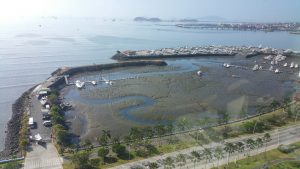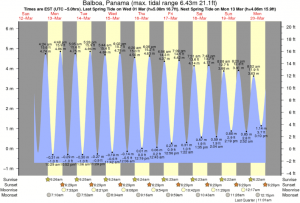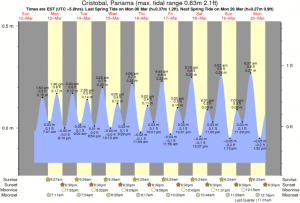What occurs on planet Earth in every 12 hours and 25 minutes?
Look at the pictures below and find the difference. That is the answer.


Even on my amateur pictures the difference made by the ebb and tide of the Pacific Ocean is quite striking.
The spot is Club De Yates y Pesca, Panama City, Panama, the pictures are taken from a hotelroom window on level 22.
SIZES
The change in water level seemed huge to me (compared to the tides of the Adriatic Sea, which I know better), so I became curious and searched the Internet for the size of the tidal range in Panama City.
The series of data are impressive. The maximum value of the tidal range of the Pacific Ocean is more than six meters at Panama City.

The value of 6 meters is even more astonishing, if you compare it with the tidal range of another place, just 80 kilometers far away from Panama City.

Here the maximum tidal range is only the tenths of the previous one, 0.63m.
Well, the trick is, that this place is located on the shore of the Atlantic Ocean.
Related to Panama City, Cristobal is just across the country Panama, at the other end of the Panama Canal.
The approximately 80 kilometer wide isthmus Panama separates two different worlds in the sense of ebb and tide. In the south the Pacific Ocean produces a tidal range of 6 meters, in the north the Atlantic Ocean generates only 0.6 meters in tidal range.
I became curious, just how much energy does it take to move this huge amount of water twice a day? It is even more important to us, that how much energy could we generate from this renewable source?
USE
The concept of harnessing the tidal energy is not new, the first tidal mills were installed during the last decades of the 8th century.
Tidal mills used the potential energy of water: during high tide sluices were open and the water rushed in and filled up a storage pond. After filling up the pond they closed the sluices and the water was released through waterwheels in order to mill grain.
Most of the tidal power systems which were put into operation during the 20th century still use the same principle. Modern engineering however has added a lot to the basics, the structures vary in design (tidal barrage, tidal lagoon, dynamic tidal power, tidal fence etc.) and the modern turbines harness the energy of tide AND ebb also.
Today’s largest systems in operation use man-made barrages. The record of the highest power is held by Sihwa Lake, South Korea with 254MW, the size of its storage basin is 30 km2. The second largest tidal power plant in the world has a power of 240MW, located on the estuary of river La Rance, Brittany, France. This plant has a basin area of 22 km2. Based on the positive experiences a new tide (!) of projects has been initiated.
Another method of harnessing the tidal energy is making use of the kinetic energy of the moving water. In some places this also has a huge potential, the energy of strong offshore currents can be harnessed far away from the coasts. Using the 4 m/s tidal current of Strangford Lough (in the east of Northern Ireland) the first commercial and grid connected tidal stream generator (1.2 MW) was put into opearation in 2007.
GREEN. Or is it?
On the one hand tidal energy is renewable. More to that, its periodicity is accurate, so it is a very reliable energy source compared to the intermittent wind or solar energy.
On the other hand, a potential disadvantage of tidal power is the effect it can have on plants and animals of the ocean. Tidal barrages can increase turbidity, the turbines can kill swimming sea life with the rotating blades and sea animals may no longer utilize the area if threatened with a constant rotating or noise-making object.
Engineers have already developed a spectrum of solutions which may help mitigate the above mentioned negative effects in the near future.
Neither the enormous CAPEX requirements nor the 8-10 year long installation period discourage the investors, there are several huge projects in the planning phase in UK, France and South Korea already.
If you would like to know more about tidal power, here is a short list of interesting sites to visit.
http://www.oceanenergycouncil.com/
http://www.alternative-energy-tutorials.com/
https://www.hydropower.org/blog/technology-case-study-sihwa-lake-tidal-power-station
http://www.tidallagoonpower.com/projects/swansea-bay/
And please remember energy talk can be interesting.
Don’t forget to subscribe!

Leave a Reply